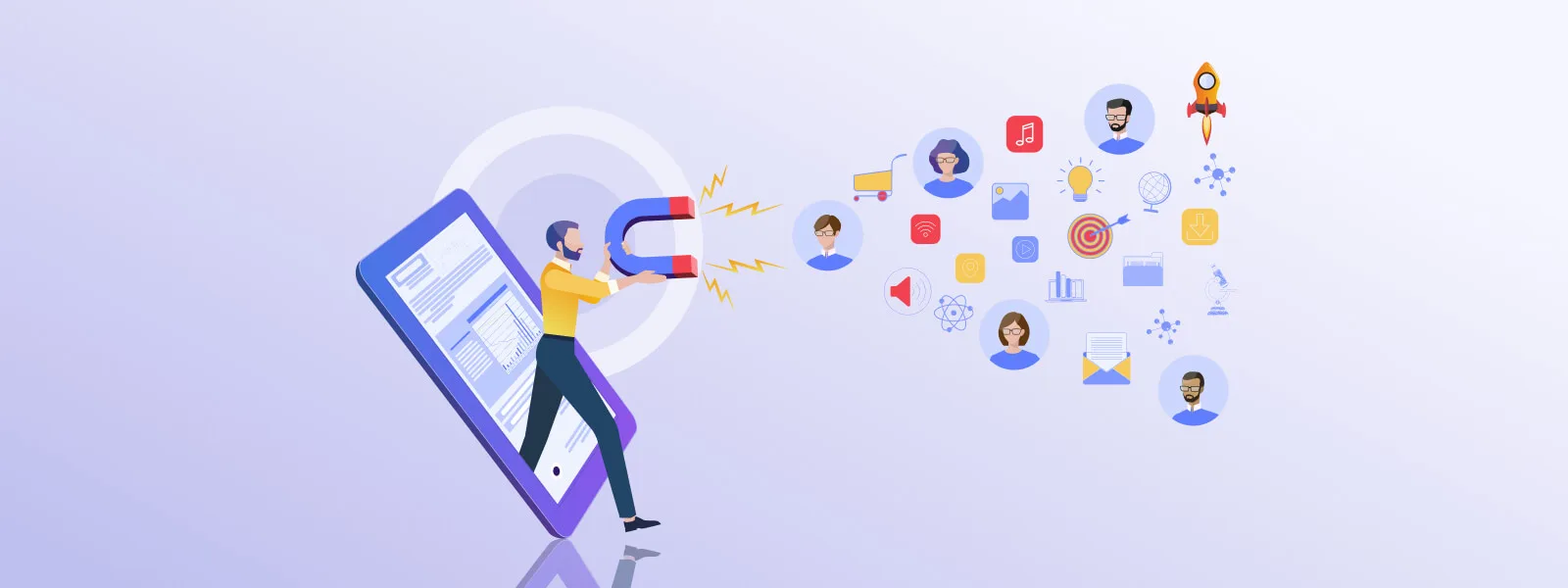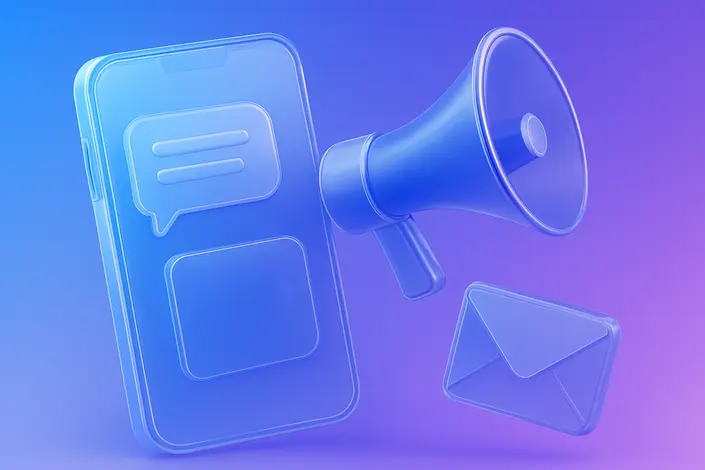What is Campaign Management and How Does It Work?
- August 20, 2025
- 19 mins read
- Listen
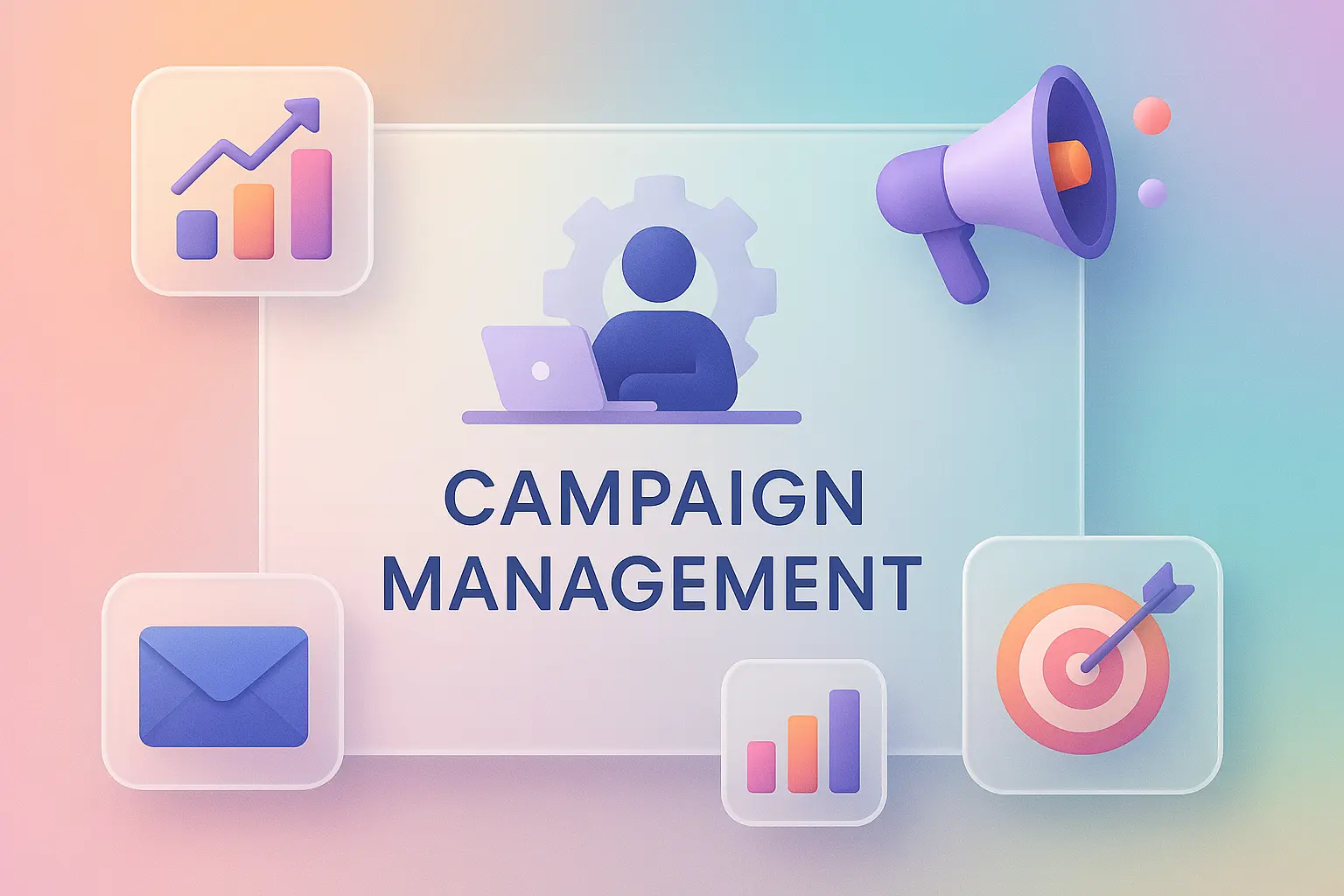
Do you know AI-powered campaigns can triple your ROI? But 50% of marketers miss out without a plan. That’s where campaign management shines.
Campaign management is your edge. It’s the art of turning chaos into wins by planning, launching, and tracking marketing efforts with laser focus.
Think of it as orchestrating a symphony: every ad, email, and post hits the right note to drive sales, boost awareness, or grow loyalty.
Ready to make your campaigns pop? Let’s jump in!
What is Campaign Management?
Campaign management is the process of planning, executing, tracking, and analyzing marketing efforts to achieve a clear goal.
It’s about steering every piece, ads, emails, social posts toward one unified message.
For example, a company might push a new product with Instagram ads, emails, and a webinar, all synchronized to spark interest and drive sales.
Unlike general marketing, which can feel like a broad net, campaign management zooms in. You pick a single objective, like growing website traffic by 20% or gaining 1,000 new leads.
Then, you align every move to make it happen. It’s strategic. It’s deliberate. And in 2026, it’s powered by data. Tools like AI analytics, think real-time insights from platforms like X, help you spot what’s working and pivot fast.
Why is Campaign Management Important?
Marketing moves at lightning speed. Trends shift overnight, and customers expect brands to keep up. Without a clear plan, your campaign can easily fizzle out, wasting time, money, and effort.
Campaign management is the backbone that keeps your marketing sharp, focused, and effective.
Let’s break down why it’s so critical.
Campaign management brings order to chaos.
Marketing campaigns juggle multiple channels, think social media, emails, and ads. Without coordination, you risk mixed messages or missed opportunities.
A solid management process aligns every piece to deliver one clear story.
For instance, a retailer launching a Black Friday sale might sync Instagram posts with targeted emails to drive traffic. This unity builds trust and keeps customers engaged.
It saves resources.
Data shows that marketers who plan campaigns proactively are 356% more likely to succeed (Inc. Magazine). Campaign management helps you set realistic budgets and timelines. You avoid overspending on underperforming ads or overloading your team.
Plus, with tools like AI analytics, you can track performance in real time and shift funds to what works best.
It fuels agility.
Conditions change rapidly. Think of new competitors or viral trends. Campaign managers monitor these shifts and adjust on the fly.
For example, if a TikTok ad isn’t clicking, they might pivot to user-generated content based on live data.
This flexibility keeps campaigns relevant and impactful.
It drives results.
By tying every action to a specific goal, like boosting sales or growing leads, campaign management ensures your efforts hit the mark.
It’s not just about launching; it’s about measuring success through metrics like conversion rates or click-throughs. This focus turns good ideas into great outcomes.
Types of Marketing Campaigns
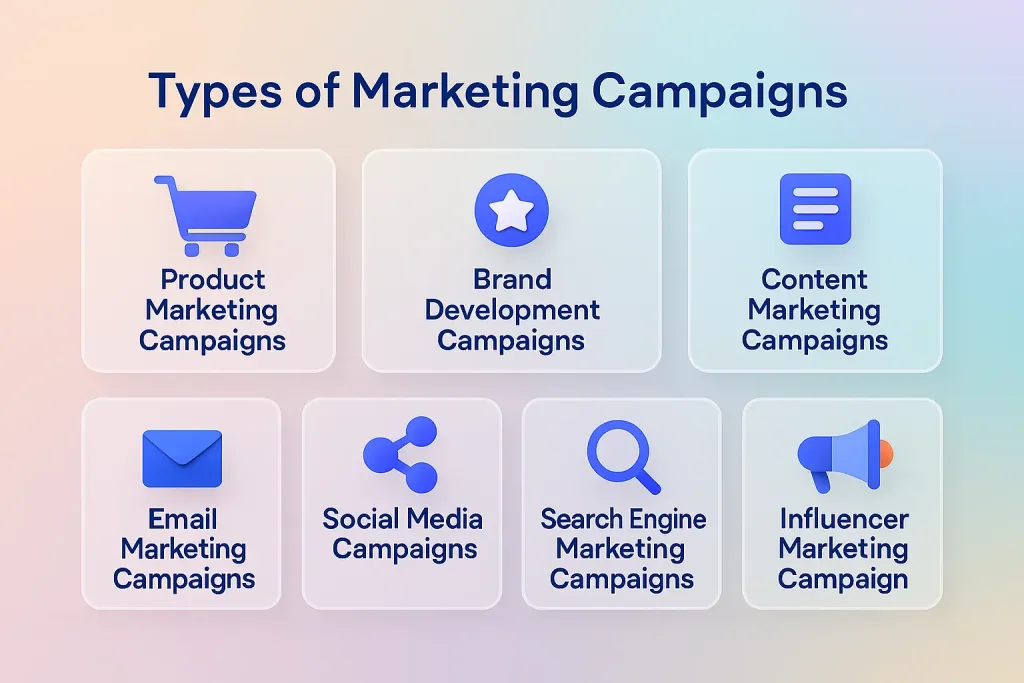
Marketing campaigns come in all shapes and sizes, each designed to hit specific goals and connect with audiences in unique ways.
Here’s a rundown of the most impactful types, with insights on how they work and why they matter. Let’s dive in.
1. Product Marketing Campaigns
Want to get people buzzing about a new offering?
Product marketing campaigns focus on promoting a specific product or service. They highlight features, benefits, or unique selling points to drive purchases.
Think of a tech company rolling out a new smartphone with sleek ads on YouTube and targeted emails to early adopters.
These campaigns shine for launches or seasonal pushes.
- Best for: Increasing sales, product awareness.
- Example: Apple’s iPhone launches with cinematic ads and in-store demos.
- Key tools: Paid ads, landing pages, email automation.
2. Brand Development Campaigns
These campaigns aren’t about selling a single product. They’re about shaping how people see your brand. They build identity, trust, and loyalty through storytelling and consistent visuals.
For instance, Nike’s “Just Do It” campaign isn’t tied to one sneaker; it’s about inspiring action.
- Best for: Boosting brand awareness, loyalty, retention.
- Example: Coca-Cola’s feel-good ads that tie to shared moments.
- Key tools: Social media, video content, PR.
3. Content Marketing Campaigns
Content is king, and these campaigns prove it. They deliver valuable, informative content like blogs, eBooks, or videos to attract and engage audiences.
A software company might share a free guide on cybersecurity to pull in leads. The goal? Position your brand as a trusted expert while driving traffic or conversions.
- Best for: Lead generation, brand trust, website traffic.
- Example: HubSpot’s blog posts that rank high on Google and draw leads.
- Key tools: CMS, keyword research tools, analytics platforms.
4. Email Marketing Campaigns
Email remains a powerhouse. These campaigns send targeted, personalized messages to nurture leads or re-engage customers. Just think of a retailer sending a discount code to someone who abandoned their cart.
With AI, emails can adapt to user behavior in real time, making them more effective in 2026.
- Best for: Nurturing leads, increasing repeat sales.
- Example: Amazon’s tailored product recommendation emails.
- Key tools: Email automation platforms, CRM integration.
5. Social Media Marketing Campaigns
Social media campaigns thrive on platforms like Instagram, TikTok, or X, where you can spark conversations and build communities.
They mix paid ads, organic posts, and user-generated content to boost engagement. A fashion brand might use influencer posts on X to showcase a new line.
It taps into real-time trends.
- Best for: Engagement, brand awareness, feedback.
- Example: McDonald’s BTS Meal campaign, which went viral with millions of mentions.
- Key tools: Social scheduling tools, analytics dashboards.
6. Search Engine Marketing (SEM) Campaigns
Want to be found when people search? SEM campaigns focus on ranking high on Google or Bing through paid ads (like PPC) or organic SEO content.
A local bakery might bid on “best cupcakes near me” to draw nearby customers. AI-driven keyword tools make these campaigns sharper.
- Best for: Lead generation, website traffic, visibility.
- Example: A travel agency’s Google Ads for “cheap flights” searches.
- Key tools: SEO tools, PPC platforms, analytics.
7. Influencer Marketing Campaigns
Influencers hold sway. These campaigns partner with creators to promote your brand authentically. A skincare brand might collaborate with a TikTok star to demo a new cream.
The key is picking influencers whose audience matches yours for genuine impact.
- Best for: Reaching niche audiences, building trust.
- Example: Allbirds’ eco-friendly shoe campaign with sustainability influencers.
- Key tools: Influencer platforms, social listening tools.
Benefits of Marketing Campaign Management
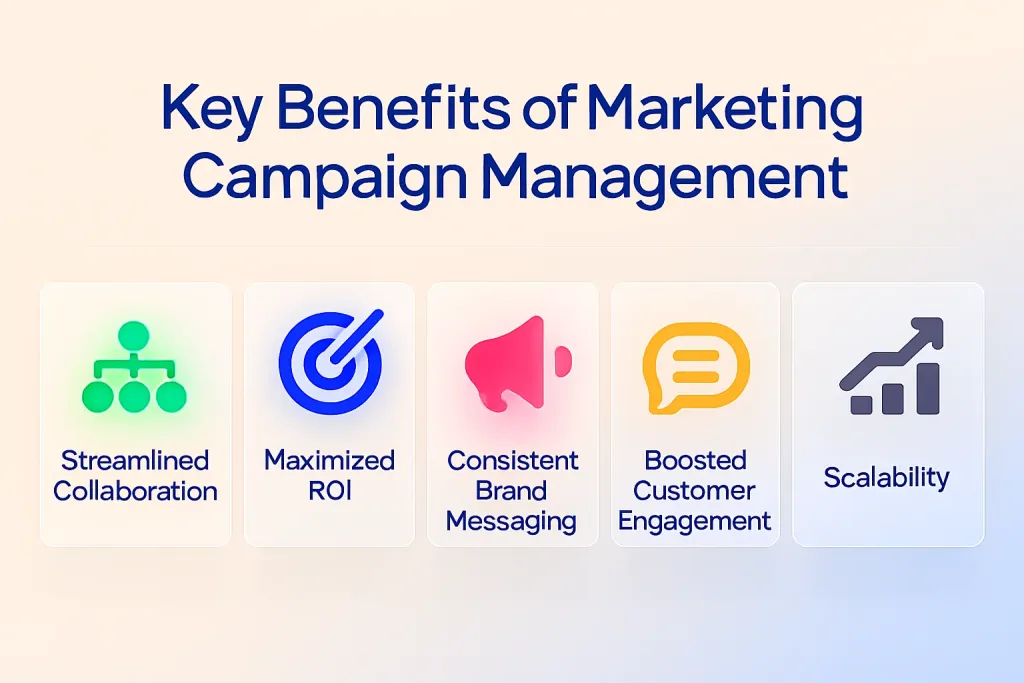
Running a marketing campaign without a solid plan is like sailing without a map. You might move, but you’re just as likely to get lost.
Here are the key benefits that make campaign management a must-have for any serious marketer. Let’s explore.
1. Streamlined Team Collaboration
Campaigns involve multiple players such as designers, writers, analysts, and more.
Without management, miscommunication creeps in, deadlines slip, and messages get muddled. Campaign management aligns everyone. It assigns clear tasks, sets deadlines, and fosters teamwork.
For example, a campaign manager might use a shared dashboard to ensure the social media team’s posts match the email team’s messaging.
This unity cuts chaos and boosts efficiency, letting teams focus on creating, not coordinating.
2. Maximized ROI and Resource Efficiency
Wasting a budget on underperforming ads or overworked staff is a marketer’s nightmare. Campaign management optimizes resources.
By setting clear budgets and tracking performance in real time, you can shift funds to high-impact channels.
]A retailer, for instance, might redirect ad spend from a weak Facebook campaign to a viral TikTok push, saving money and driving results.
3. Consistent Brand Messaging
Customers crave consistency. A scattered campaign with mismatched tones confuses them. Campaign management ensures every ad, post, or email reflects your brand’s voice and values.
Think of Nike’s “Just Do It”, every channel echoes that bold vibe. With audiences hopping between X, Instagram, and email, a unified message builds trust and loyalty.
Management tools help review assets to keep them on-brand, no matter the platform.
4. Enhanced Agility in a Fast-Paced World
Trends move at warp speed. A viral moment on X or a competitor’s surprise launch can shift the game overnight.
Campaign management keeps you nimble. Managers monitor real-time data like engagement spikes or sentiment shifts and pivot fast.
5. Boosted Customer Engagement and Retention
Great campaigns don’t just attract, they keep customers coming back.
Campaign management uses audience insights to craft personalized experiences. AI-driven tools can segment audiences by behavior or preferences, delivering tailored content.
Just think of an email campaign that sends a discount to a customer who browsed but didn’t buy. This precision drives engagement and builds loyalty.
It also turns one-time buyers into repeat fans.
6. Scalability for Growing Ambitions
Whether you’re a startup or a global brand, campaign management scales with you.
It creates repeatable processes, think templates or automated workflows that save time as campaigns grow.
A small business might start with a single email campaign, while an enterprise runs global social media pushes.
7. Data-Driven Success
Guessing what works is risky. Campaign management leans on data to measure and improve. Metrics like click-through rates, conversions, or social engagement show what’s hitting the mark.
For instance, a SaaS company might find webinars outperform blogs for lead generation, then double down.
With real-time analytics, you make informed choices, not shots in the dark. This focus drives higher conversions and proves your campaign’s worth.
How Does Campaign Management Work? A Step-by-Step Guide
Launching a marketing campaign without a clear plan is like cooking without a recipe, things might turn out okay, but you’re just as likely to burn the kitchen down.
Whether you’re boosting brand awareness or driving sales, these eight steps will guide you from start to finish.
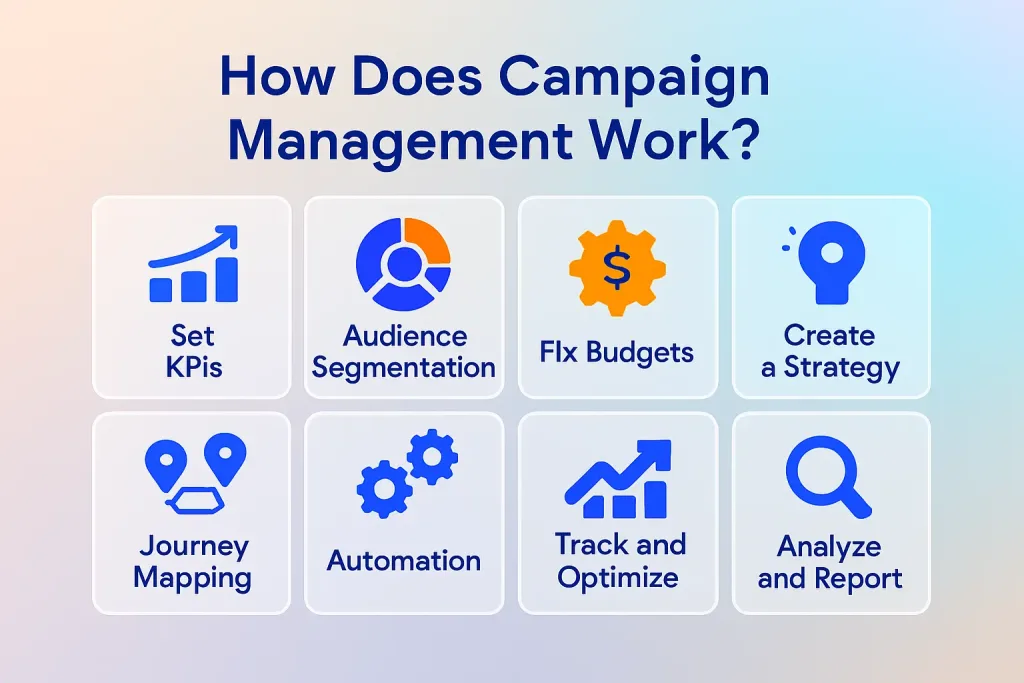
Let’s walk through each one, packed with practical tips to make your campaigns shine.
1. Set Goals and KPIs
Every great campaign starts with a clear target. Want to grow website traffic by 20%? Generate 500 new leads? Increase sales by $50,000?
Define specific, measurable, achievable, relevant, and time-bound (SMART) goals. These anchor your campaign.
For example, a coffee shop might aim to sell 1,000 lattes in a month through a fall promotion.
Next, pick key performance indicators (KPIs) like click-through rates or conversions to track progress. Involve stakeholders early to align with bigger business goals.
Clear goals keep everyone focused and make success easy to measure.
2. Audience Research and Segmentation
You can’t hit a target you don’t understand. Research your audience to learn their habits, needs, and pain points.
Use surveys, social listening, or CRM data to dig deep.
For instance, a fitness brand might find its audience includes gym-goers aged 25-35 who value sustainability. Segment them into groups like “eco-conscious runners” or “yoga enthusiasts” to tailor your messaging.
AI tools can analyze behaviors, splitting audiences by demographics or purchase patterns. This precision ensures your campaign speaks directly to the right people.
3. Budget and Resources
Money and time are finite, so plan wisely.
Estimate costs for ads, content creation, and tools. Look at past campaigns to gauge needs. For example, $5,000 for social ads or $2,000 for freelancers.
Factor in team bandwidth too. A small team might need to outsource video editing. While a larger one can handle it in-house. AI-driven platforms can optimize ad spend in real time, stretching your budget further.
Get stakeholder approval to lock in funds. A clear budget keeps your campaign lean and effective, avoiding costly surprises.
4. Strategy, Narrative, and Channels
Now, craft the big picture. Build a narrative that resonates. Maybe a story of empowerment for a sportswear brand. Choose channels based on your audience.
If they’re on TikTok, prioritize short videos; if they’re professionals, try LinkedIn ads. A multichannel approach like pairing X posts with email drips, often works best.
Map out a strategy that aligns content with goals. For example, a SaaS company might use webinars for leads and blogs for awareness.
Test channels early to find what clicks. A strong narrative ties it all together.
5. Content Creation and Journey Mapping
Create content that’s engaging, personalized, and on-brand. Think blog posts, videos, or Instagram reels tailored to each audience segment.
A pet store might share a heartfelt video for pet owners and a blog for first-time buyers. Map the customer journey such as awareness, consideration, and decision to guide them.
For instance, a social ad sparks interest, a webinar builds trust, and an email seals the deal. Use AI to personalize at scale, like tweaking email copy based on user actions.
Keep content focused and actionable.
6. Automation and Launch
Automation tools streamline repetitive tasks, like scheduling posts or sending emails triggered by user clicks.
Platforms like X can push real-time updates, keeping your campaign fresh. Before launching, test everything including links, visuals, and CTAs. A/B test headlines or ad designs to see what performs best.
For example, a retailer might test two email subject lines to boost open rates. Launch strategically, timing posts for peak engagement (e.g., 7 p.m. on weekdays).
Automation ensures a smooth rollout while saving time.
7. Tracking and Optimization
Once live, watch closely. Track KPIs like click-through rates, conversions, or social engagement using analytics tools.
AI can spot trends fast. If an ad underperforms, pivot. A fashion brand might swap a low-performing TikTok ad for user-generated content mid-campaign.
Regular check-ins catch issues early. Optimization isn’t a one-off; it’s ongoing. Test variables like send times or visuals to boost results.
Data-driven tweaks keep your campaign on track and maximize impact.
8. Analysis and Reporting
When the campaign wraps, it’s time to reflect. Compare results to your KPIs. Did you hit that 20% traffic goal? Generate those 500 leads?
Use analytics to dig into what worked. Maybe emails drove 60% of conversions, but blogs lagged. Create clear reports for stakeholders, highlighting ROI and lessons learned.
For example, a campaign showing high engagement might inform future social strategies. Store insights for next time.
This step isn’t just about grading your work. It’s about building smarter campaigns down the road.
Campaign Management Software: Features to Look For
Running a marketing campaign without the right tools is like trying to navigate a storm without a compass. Campaign management software is your lifeline, streamlining tasks, boosting efficiency, and driving results.
With so many options out there, picking the right one can feel overwhelming. Here are the must-have features to look for in campaign management software, designed to make your campaigns soar.
Let’s dive into what matters most.
1. Centralized Dashboard
A cluttered campaign is a failing campaign. A centralized dashboard acts as your control center, giving a clear view of all tasks, timelines, and metrics in one place.
2. Multi-Channel Integration
Your audience isn’t just on one platform. They’re everywhere. Great software connects seamlessly with email, social media (like X or TikTok), paid ads, and even CRM systems. This ensures your campaign delivers a consistent message across channels.
3. Automation Capabilities
Manual tasks eat time and invite errors. Automation is a game-changer, handling repetitive jobs like scheduling posts or sending follow-up emails. Look for tools offering workflows, triggers, and A/B testing to streamline launches and boost engagement without extra effort.
4. Advanced Analytics and Reporting
Data drives decisions. Top software provides real-time analytics to track KPIs like click-through rates, conversions, or ROI. A SaaS company might discover webinars outperform blogs for leads, thanks to detailed reports.
5. Audience Segmentation
Generic messages flop. Segmentation lets you tailor campaigns to specific groups based on behavior, demographics, or interests.
AI-enhanced tools can segment dynamically, adjusting as users interact. Make sure your software supports robust segmentation to make every message feel personal and relevant.
6. Collaboration and Workflow Tools
Campaigns thrive on teamwork. Software should offer task assignments, shared calendars, and real-time updates to keep everyone aligned.
A marketing team might assign designers to create visuals while analysts track ad performance, all within one platform.
Look for features like role-based access, comment threads, and file sharing to cut down on email chains and keep projects moving smoothly.
7. Budget Tracking and Management
Overspending kills campaigns. Good software includes budget tools to monitor costs for ads, content, or freelancers.
A small business might set a $3,000 cap for a product launch, with alerts for overspending. Real-time tracking, paired with AI optimization, helps shift funds to high-performing channels.
Choose a platform with clear budget dashboards to stay financially on track.
8. AI-Powered Features
AI is non-negotiable. Look for software with AI tools like predictive analytics, content generation, or sentiment analysis.
For instance, a retailer could use AI to craft email subject lines that boost open rates or analyze social media posts for real-time feedback.
These features save time and sharpen campaigns, making your efforts smarter and more impactful.
9. Chatbot Integration
Chatbots are revolutionizing campaigns in 2026, and the right software should integrate them seamlessly.
A chatbot, like those powered by advanced AI, can engage customers 24/7, answer queries, and guide them through the sales funnel.
Chatbot can greet website visitors, recommend products based on browsing history, and even recover abandoned carts by sending personalized offers.
Integrated with campaign software, it syncs with your email or social campaigns. And it ensures a unified customer experience.
10. Scalability and Customization
Your business will grow, and your software should keep up. Scalable platforms support small startups and global enterprises alike, handling everything from single email campaigns to complex multichannel pushes.
Customization like tailored workflows or branded templates ensures the tool fits your needs.
A growing e-commerce brand might start with basic emails and later add social ads. All within the same system.
Best Practices for Effective Campaign Management
Marketing campaigns can make or break a brand in a heartbeat. With audiences jumping between platforms like X and TikTok, and AI reshaping how we connect, running a campaign without a solid strategy is like throwing darts blindfolded.
Let’s explore how they’re designed to keep your efforts sharp, efficient, and impactful.
1. Start with Crystal-Clear Goals
Vague goals lead to vague results. Define specific, measurable objectives using the SMART framework (Specific, Measurable, Achievable, Relevant, Time-bound).
Want to boost website visits by 15% in 30 days? Or gain 1,000 email subscribers? Nail down your target and KPIs upfront.
2. Know Your Audience Inside Out
Great campaigns speak directly to their audience. Use data, surveys, CRM insights, or social listening on Facebook to understand preferences, behaviors, and pain points.
A pet brand might learn dog owners want eco-friendly toys. Segment audiences (e.g., “new pet owners” vs. “long-time buyers”) and tailor content to each group.
AI tools can refine segments in real time, ensuring your message lands with precision.
3. Leverage Data-Driven Decisions
Guesswork is risky. Base every move on data, from channel selection to content tweaks.
Use analytics to track KPIs like click-through rates or conversions. For instance, a tech startup might find LinkedIn ads outperform Instagram based on engagement data.
AI-driven tools, like those analyzing social media trends, can spot shifts fast. A viral hashtag to jump on.
Data keeps your campaign grounded and effective.
4. Stay Agile and Ready to Pivot
The marketing world moves fast. A competitor’s launch or a trending social media post can change the game overnight.
Monitor campaigns in real time and be ready to adjust. If a TikTok ad flops, swap it for user-generated content. Regular check-ins daily or weekly help catch issues early.
Agility ensures your campaign stays relevant, no matter what 2026 throws your way.
5. Test, Test, and Test Again
Don’t assume what works, prove it. A/B test elements like email subject lines, ad visuals, or posting times.
A retailer might test two headlines to see which drives more clicks. Use AI to run tests at scale, analyzing results instantly.
Testing reveals what resonates, letting you optimize mid-campaign for better results.
6. Prioritize Consistency Across Channels
Mixed messages confuse customers. Ensure every ad, post, or email aligns with your brand’s voice and story.
A fashion brand’s empowering narrative should feel the same on X, email, or billboards.
Use campaign management software to review assets and catch inconsistencies. Consistent messaging builds trust and keeps audiences engaged across platforms.
7. Automate Where It Counts
Time is precious. Use automation to handle repetitive tasks like scheduling posts or sending emails triggered by user actions.
A bookstore might automate a “new release” email when someone browses a genre. AI-enhanced tools can personalize at scale, like tweaking offers based on behavior.
Automation frees your team to focus on strategy and creativity.
8. Integrate Chatbots for Engagement
Chatbots are a secret weapon. A retail chatbot, like those powered by advanced AI, can engage customers 24/7, answer questions, and nudge them toward purchases.
Sync it with your campaign software to track interactions. It ensures a seamless experience across email, social, or ads.
10. Learn from Every Campaign
Every campaign is a lesson. After wrapping, analyze results against your KPIs. Did you hit your 15% traffic goal? Why did emails outperform social ads?
Create detailed reports for stakeholders, highlighting ROI and insights. A campaign with high engagement might shape your next social strategy.
Store findings to make future campaigns sharper and more effective.
Conclusion
Marketing campaigns are a high-stakes game, but with solid campaign management, you’re set to win.
Its from setting clear goals to leveraging AI-powered tools and chatbots, every step counts. You’ve learned how to align teams, craft compelling narratives, and track results with precision.
Whether you’re launching a product, building a brand, or engaging customers on platforms on social media, effective campaign management turns ideas into impact.
It saves time, boosts ROI, and keeps your audience hooked.



